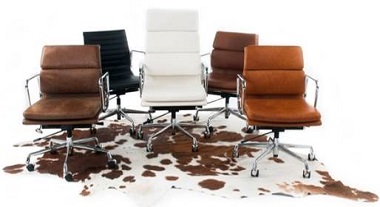The Ultimate Guide to Choosing the Right Office Chair in 2024
As we step into 2024, the quest for the perfect office chair remains a top priority for businesses and remote workers alike. A well-designed chair not only enhances productivity but also contributes to overall well-being.

In this comprehensive guide, we delve into the key factors to consider when choosing the right office chair, ensuring that your seating choice aligns with the demands of the contemporary work environment.
1. Ergonomics: A Foundation for Comfort
Ergonomics is the science of designing products to maximize human well-being and overall system performance. When it comes to office chairs, prioritizing ergonomic features is non-negotiable. Look for chairs that offer:
a. Adjustable Lumbar Support:
A good office chair should provide proper lumbar support to maintain the natural curve of your spine. Opt for chairs with adjustable lumbar support to accommodate different body types and preferences.
b. Adjustable Armrests:
Adjustable armrests contribute to a more comfortable sitting experience by allowing you to align them with your desk height. This feature helps prevent shoulder and neck strain.
c. Seat Height and Tilt Adjustability:
The ability to adjust the height and tilt of the seat ensures that your feet are flat on the floor, promoting proper posture and reducing pressure on the lower back.
d. Headrests for Neck Support:
For those who spend long hours at the desk, a chair with an adjustable headrest can provide crucial support for the neck and upper spine.
2. Material Matters: Comfort and Durability
The material of your office chair plays a significant role in both comfort and durability. Consider the following options:
a. Mesh Chairs:
Mesh chairs offer breathability, preventing heat buildup during extended periods of sitting. They are also known for providing excellent lumbar support and a modern aesthetic.
b. Leather or Upholstered Chairs:
If you prioritize a more executive or traditional look, leather or upholstered chairs may be the right choice. These chairs are not only stylish but also durable, though they may require more maintenance.
c. Hybrid Materials:
Some chairs combine materials for optimal comfort and support. Hybrid options often feature a mesh back for breathability and a cushioned seat for added comfort.
3. Mobility and Swivel: Navigating the Workspace
An office chair should facilitate easy movement and access to different parts of your workstation. Look for chairs with:
a. 360-Degree Swivel:
A chair that swivels 360 degrees provides flexibility and ease of movement, allowing you to access various areas of your desk without strain.
b. Smooth Rolling Casters:
Invest in a chair with smooth-rolling casters suitable for your office floor. This ensures that you can move effortlessly without causing damage to the flooring surface.
c. Stability and Weight Capacity:
Consider the stability of the chair, especially if you tend to shift positions frequently. Additionally, check the weight capacity to ensure the chair can comfortably support your body weight.
4. Style and Aesthetic Appeal: Harmonizing with Your Workspace
While comfort and functionality are paramount, the visual appeal of your office chair also matters. The chair should seamlessly integrate with your workspace aesthetic. Consider:
a. Color and Design:
Choose a chair color and design that complements your office decor. Whether you prefer a sleek, modern look or a classic executive style, there are numerous options to suit your taste.
b. Size and Space Considerations:
Ensure that the size of the chair aligns with your workspace dimensions. A chair that is too large can make the office feel cramped, while one that is too small may compromise comfort.
Also Read | Storage Solutions for a Clutter-Free Office: Cabinets, Shelves, and More
5. Technology Integration: Staying Connected
In the era of smart offices, some chairs come equipped with technology integration features. Consider chairs that offer:
a. Built-in USB Ports:
Chairs with built-in USB ports allow you to charge devices conveniently, ensuring that you stay connected and powered throughout the workday.
b. Wireless Connectivity:
Some advanced chairs may feature wireless connectivity for seamless integration with other smart office devices, enhancing overall functionality.
6. Adjustability for Varied Tasks: Adapting to Your Work Requirements
Every work task may demand a slightly different sitting position. An ideal office chair should provide the flexibility to adapt to various tasks, including:
a. Recline Functionality:
For tasks that require a more relaxed posture, a chair with a recline function can be beneficial. Look for options with adjustable recline angles and tension control.
b. Tilt Lock Mechanism:
A tilt lock mechanism allows you to lock the chair in a specific position, providing stability when needed, especially during tasks that require precision and focus.
7. Budget Considerations: Balancing Cost and Quality
While it's tempting to prioritize budget, remember that an office chair is an investment in your comfort and well-being. Striking a balance between cost and quality is essential. Consider:
a. Warranty and Durability:
Check the warranty offered by the manufacturer. A more extended warranty period often indicates the manufacturer's confidence in the chair's durability.
b. Long-Term Value:
Assess the long-term value of the chair. While a higher upfront cost might be intimidating, a durable and comfortable chair can prevent health issues and provide lasting value over time.
Your Seat of Productivity and Well-Being
As we navigate the ever-evolving landscape of work, the importance of choosing the right office chair cannot be overstated. It is not merely a piece of furniture but a tool that directly impacts your productivity, health, and overall work experience. By considering ergonomic design, material, mobility, style, technology integration, adjustability, and budget, you can find the perfect chair that aligns with the demands of the contemporary workplace. Remember, the ultimate office chair is the one that supports you in your quest for success, comfort, and well-being throughout the workday and beyond.
- 30.11.2023
-
Category:
- Mesh Chair